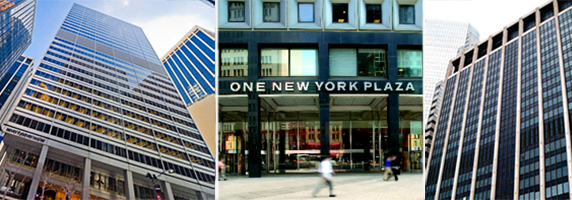When Tucker Reed learned of JDS Development Group’s plans to bring a 1,000-foot tower to Downtown Brooklyn, he became, in his own words, a bit “emotional.” He recounted the moment during a panel last month, saying the proposed rental tower at 9 Dekalb Avenue would help address the massive population growth expected in the borough.
“People are freaking out, saying ‘Oh my God it’s too much,’” he said, referring to attempts to squash the project. “As a 21st-century Brooklyn, we shouldn’t be afraid of embracing our new skyline, our new growth.”
As president of the Downtown Brooklyn Partnership, Reed [TRDataCustom] has embraced the role of champion of new development. The Partnership oversees three business improvement districts (BIDs), nonprofits dedicated to promoting economic growth that are fueled by assessments, or special taxes paid by property and business owners. Neighborhoods have turned to BIDs as a way to supplement services that the city wasn’t providing, often in the form of sanitation and public safety.
Today, there are 72 BIDs across the city that invested $172 million in those districts in 2015, according to the Department of Small Business Services. But some of the largest BIDs have evolved into much more than quality-of-life boosters. The Partnership and the Downtown Alliance, whose boards include some of the city’s biggest real estate players, have positioned their districts as burgeoning commercial hubs desperately in need of new development. They act as quasi-governmental bodies, public relations machines, cheerleaders and ultimately, self-appointed leaders of the neighborhoods they serve. And though they wear many prominent hats, they face little government oversight.
“It’s gotten to the point where they try to figure out what else they can do,” said Rachel Meltzer, a professor of urban policy at the New School. “Should the BID just be an organization focused on maintenance? I think there’s a feeling that these BIDs want to be more than that.”
History lesson
In 1984, the city’s first BID sprouted up in the Union Square-14th Street area. It was followed by a flurry of others, and the organizations were seen as change agents in troubled neighborhoods. The Bryant Park BID, for example, was credited with sweeping away an open-air drug market and creating a viable public space for lunch breaks and community activities.
In the 1990s, Lower Manhattan landlords saw vacancy rates in their office buildings climb to alarming levels, hitting a staggering 20.7 percent in 1996, according to Cushman & Wakefield. The area was “in the depths of what can only be called a depression,” said Carl Weisbrod, now director of the Department of City Planning. “It was a one-dimensional neighborhood. Literally, it closed down at 5. Companies were moving out. Every major corporation thought it would be the last to turn out the lights.”
In 1995, Weisbrod and others set out to form what would become one of the city’s largest BIDs, the Downtown Alliance. It encouraged economic development in the area, in part by pushing the city to rezone part of the neighborhood for residential use. Weisbrod, who became the BID’s first president, said the key was to not only change the perception of downtown but also to reposition it economically.
“It’s really an amazing transformation of this part of the city,” he said, calling it “a model for what older downtowns across the country have now done.”
But then came 9/11, which brought everything to a halt. The Downtown Alliance helped to create a grant-and-loan program to aid small businesses near Ground Zero, in which it distributed more than $37 million. It also launched a print and ad campaign, “Remember, Rebuild.” Larry Silverstein, in a 2008 speech at an Alliance event at Cipriani Wall Street, lauded its efforts.
The BID, he said, had helped usher in a “permanent transformation” of the neighborhood.
“The sheer breadth and diversity of the new Downtown economy makes it more durable and more lasting than at any point in its history,” he said.
Stiletto to the heart
The Alliance defines its district as, roughly, the area south of Murray Street, from City Hall to the Battery, and from the East River to West Street. Like many of the city’s BIDs, its board is dominated by major real estate players, including Janno Lieber of Silverstein Properties, Seth Pinsky of RXR Realty and Ric Clark of Brookfield Property Partners. Nearly half — 20 out of 43 — of the board members come from the industry. Annual expenses for the Alliance tallied $19.9 million in 2015, the most of any BID that year, according to the New York City Small Businesses Services. By total assessment ( $15.9 million) and revenue ($19.8 million), it was second only to the Times Square Alliance.
The BID spent $4.7 million, or 23.5 percent of its total budget, on marketing, promoting a well-honed narrative that the community is turning into a TAMI tenant hub.

When Condé Nast announced in 2014 that it would move to One World Trade Center, Jessica Lappin, the Alliance’s president, told the New York Times the move would put “a stiletto in the heart of the outdated notion that Lower Manhattan is stuffy and gray.”
But now, the area is again facing a big change. It recently lost one of its most powerful advocates in Albany, former Assembly Speaker Sheldon Silver, who in April was sentenced to 12 years in prison after being convicted on federal corruption charges.
“Whenever the speaker of any legislative body represents a community, that’s an advantage for that community. That’s just a political reality,” Lappin told The Real Deal. “[Former Speaker of the House John] Boehner’s constituents aren’t as well off today as they were a couple years ago. That’s the nature of the process. If you live in Paul Ryan’s district, you are psyched.”
She added, “Transitions are transitions. We’ll move forward, and it will be a new era and change can be good.”
Lappin, a former city council member who took over the Alliance in 2014, and the BID’s research team push the TAMI hub message through the BID’s quarterly and annual market reports, as well as its “Brain Gain” reports, which document what it calls a “monumental shift” in the number of yuppies who live within easy commuting distance.
Sometimes, she tries directly to coax a tenant to move to the area.
“Our main goal is to make sure that this neighborhood is vibrant,” she said. “In order for this neighborhood to be vibrant, these buildings need to be full.”
The data for the BID’s reports are culled from several different sources, including Cushman & Wakefield, CBRE, CoStar and data provided directly by developers. They do note market weaknesses, but generally portray a gung-ho outlook.
“The horizon in 2016 and beyond promises a flurry of momentous retail developments,” the BID’s 2016 first-quarter report states. “By 2019, Lower Manhattan will have more than 6.7 million square feet of retail, an expansion of 2.3 million square feet of new and repositioned space.”

Rendering of 2 World Trade Center
A lot of that space, however, is yet to be spoken for. Silverstein Properties, for one, was dealt a big blow in January, when News Corp. and 21st Century Fox canned plans to lease 1.3 million square feet at 2 World Trade Center, leaving the developer without an anchor tenant and indefinitely postponing construction of the tower.
The BID also has pushed for the conversion of more than 100,000 square feet of arcade space along Water Street into retail space, a plan that was approved by the City Council in June. RXR’s Pinsky said the Alliance was integral to kickstarting the effort. RXR’s 32 Old Slip — located just off Water Street at Front Street and Old Slip — is one of the buildings that will benefit from the rezoning.
BIDs don’t have a uniform policy on supporting or opposing new developments in their districts, and Pinsky said the Alliance does a good job of representing a wide array of interests.
“In my experience, the BIDs tend to get involved on a more strategic level, than a tactical level,” he said. “It’s not just one building or the interest of one owner, but something that’s going to have a wider benefit across the district.”

From left: 77 Water Street, One New York Plaza and 100 Wall Street
But the Alliance has been criticized for being too heavy-handed. In May, it landed in hot water after a push poll went out urging support for the Water Street initiative. Community Board 1 member Paul Hovitz received a call that showed a fake caller ID for Councilwoman Margaret Chin’s office, the Downtown Express reported. The Alliance and its designated marketing firm Global Strategy Group couldn’t explain how the mix-up occurred but denied that they had any role in the campaign. Eventually, Political Connection, a phone-bank firm hired by Global, took responsibility for the incident.
“There is a great deal of public support for this proposal, we’ve tried to organize it and there’s absolutely no need for any kind of misdirection or fake caller ID to manifest that support,” Andrew Breslau, a spokesperson for the Alliance, told the Express at the time.
Build, baby, build
Like the Alliance, the Downtown Brooklyn Partnership, formed in 2006, has a well-established narrative for its dominion: Demand is high for office space while supply is woefully low.
In its 2015 fourth-quarter market report, the Partnership, citing data from Newmark Grubb Knight Frank, pegged office vacancy at 1.7 percent — the lowest in Downtown Brooklyn’s history. But it should be noted that citing vacancy is highly unusual: All major brokerages, including NGKF, use office availability as the standard metric — vacancy, sources said, does not paint an accurate picture of supply and demand, as nonvacant space may also be available for a tenant to move into.
Reed said the area is a “victim of its own success,” and has been forced to turn away businesses due to lack of supply. For this reason, the Partnership has been “sounding the opportunity bell” for developers to build new office space, he said.
Last week, Bloomberg reported on how the slowdown in the tech industry was affecting TAMI leasing activity in Manhattan, and suggested that Brooklyn’s emergence as a tech hub could be at risk. Reed was quick to counter that narrative, saying he “totally” disagreed “with the premise that the innovation economy is slowing in Brooklyn.”
Reed, who formerly worked for the Bloomberg administration and Two Trees Management, became president of the Partnership in 2011, and his 2014 salary was $300,000, tax records show. He’ll be stepping down in early August, and the organization is yet to choose a successor.
The Partnership oversees three separate BIDs: the MetroTech BID, the Fulton Mall Improvement Association and the Court-Livingston-Schermerhorn BID, which combined had an assessment of $4.9 million in 2015 and has a total operating budget of $11.5 million. It also functions as a local development corporation, a private nonprofit that can buy and lease land from the city or state without going through a public bidding process. It plays a hand in several projects in the district, including the development of 30,000 square feet of artist studios, an initiative to combine disconnected parks to form the “Brooklyn Strand” and the proposed Brooklyn-Queens light rail.
“It’s really emerged as a key player in the broader planning and development issues here,” said Paul Travis, a managing director of Washington Square Partners and a member of the Partnership’s board.
Like the Alliance, the Partnership’s leadership is heavily skewed toward real estate figures. At least 50 of the organization’s 73 board of directors are affiliated with the industry, and 30 of them are developers.
Criticism of BIDs over the years tends to revolve around minimal oversight and lack of residential representation — BIDs in New York are only required to have one tenant on their boards. An essay in the Yale Law & Policy Review in 1996, “Restraining the Power of Business Improvement Districts,” called the nonprofit status of these organizations “undemocratic” and “unwarranted,” arguing they are designed to enrich business owners rather than benefit the neighborhood.
“By treating the Downtown Brooklyn Partnership as the leading or exclusive voice on issues in the area around Downtown Brooklyn, that ensures that the voices of landowners and developers get prioritized, with less attention to contrasting views and more representative voices,” said Norman Oder, a Brooklyn journalist who runs the watchdog blog Atlantic Yards/Pacific Park report. He noted that Forest City Ratner CEO MaryAnne Gilmartin serves as co-chair of the Partnership’s board.
The New School’s Meltzer said there’s little coordination between the city and the organizations to assure that public resources are distributed smartly. The city, she said should do a better job of shifting resources from areas with deeper-pocketed BIDs to areas that need more support.
“BIDs, I think, often get a bad rep. I’m of the mind that they are theoretically a neat idea,” Meltzer said. They “can play an important role, but it requires coordination with the city to do that.”
Still, the mayor and city council members are automatically part of each BID’s board. The city’s Small Business Services also serves an administrative role, coordinating each BID’s assessment and helping to connect organizations to other city agencies, said Gregg Bishop, commissioner of SBS.
“It’s exactly like a nonprofit. They are self-governing,” he said. “If there’s an issue with the way the organization is functioning, any board member can speak up.”
Despite the developer-heavy makeup of the board, Reed insisted the Partnership tries to do what’s best for the entire community.
“I often kind of think of the space that we occupy as the well-informed, uncomfortable position,” he said. “Meaning that we probably know, better than anyone — maybe some community groups and maybe the elected officials have as good a finger pulse on it as we do — what the players are, what the gaps in the marketplace are, what the gaps in public services are, because that’s what we do. We focus on it 24/7, right? That’s our job.”
He added, “That’s difficult to navigate, of course. There’s a fine line you have to walk. You want to do what’s best for the neighborhood and you also want to keep people as happy as possible.”
